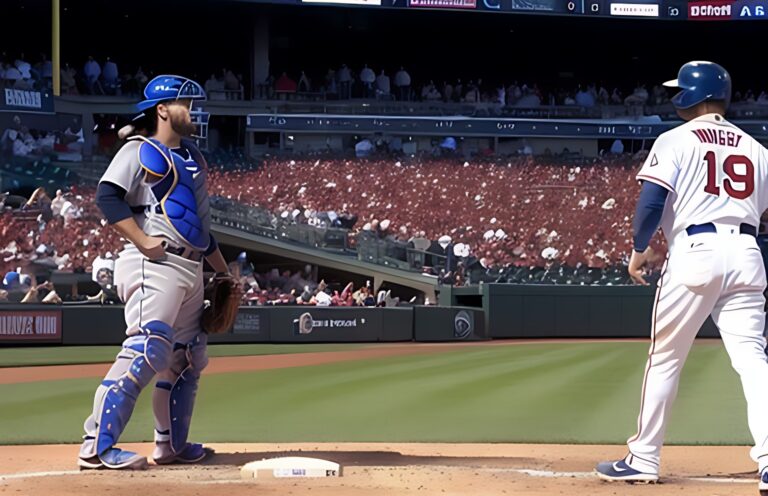What Does Bpf Mean on a Baseball Bat?
Have you ever come across the term “BPF” when shopping for a baseball bat and found yourself wondering what it means?
In the world of Little League, USSSA (United States Specialty Sports Association), and NSA (National Softball Association), the Bat Performance Factor, or BPF, plays a crucial role in determining the bat’s performance and compliance with league regulations.
The BPF is intricately connected to the bat-ball coefficient of restitution, commonly referred to as BBCOR.
Similar to the definition used for the ball, the BPF serves as a measurement of the bat’s trampoline effect and the resulting energy transfer upon contact.
Understanding BPF is essential for players, coaches, and parents alike, as it directly impacts the bat’s legality and performance within various leagues.
In this article, we will delve deeper into the concept of BPF, demystifying its meaning and shedding light on its significance in the world of baseball.
Whether you’re a seasoned player or a curious enthusiast, join us as we unravel the mystery behind the question, “What does BPF mean on a baseball bat?”
See Also: How to Hang a Baseball Bat on the Wall
The Concept of Bpf
As you step up to the plate, you can’t help but wonder, “What does Bpf mean on a baseball bat?” It’s time to unveil the mystery behind those three intriguing letters that hold the key to bat performance. Get ready to dive deep into the realm of Bpf – the secret sauce of baseball bats.
Defining Bpf and its abbreviation
Let’s start by deciphering the enigma. Bpf stands for Batted Ball Coefficient of Restitution. Phew, that’s a mouthful! But fear not, we’ll break it down for you. In simple terms, Bpf is a measure of how effectively a bat transfers the energy from a ball’s impact back into the ball itself. It’s like a bat’s rebound ability if you will.
Understanding the physics behind Bpf
Now, let’s get a little scientific. Bpf is deeply rooted in the laws of physics. When a baseball collides with a bat, energy is exchanged between the two. The Bpf rating quantifies the efficiency of this energy transfer. The higher the Bpf rating, the more energy the bat returns to the ball, resulting in greater hitting power and distance.
Impact of Bpf on a baseball bat’s Performance
So, why should you care about Bpf? Well, my friend, Bpf holds the key to unlocking a bat’s potential. It directly affects the bat’s “pop” or trampoline effect, influencing how far and how hard the ball travels when you connect with it. Think of it as the difference between a bat that sings with power and sends the ball soaring versus a bat that feels lackluster and leaves you longing for more.
But here’s the kicker: Bpf doesn’t exist in a vacuum. It’s tightly intertwined with regulations and standards set by baseball leagues. These standards ensure fair play, maintaining a balance between bat performance and the integrity of the game. So, understanding Bpf is not only about gaining a competitive edge but also about staying within the rules of the game.
Intrigued? Ready to dive even deeper into the rabbit hole of Bpf? Buckle up, my friend, as we embark on a journey to explore the certification process, interpret Bpf ratings, and uncover the factors that influence this mystical metric. By the end, you’ll be armed with the knowledge to make informed decisions and swing with confidence.
See Also: How to Tell if a Baseball Bat is Dead
Bpf Certification Process
Imagine a top-secret laboratory buzzing with scientific equipment and bat-wielding experts. This is where the magic happens, my friend. Welcome to the world of the Bpf certification process, where bats undergo rigorous testing to earn their seal of approval. Get ready to peek behind the curtain and discover the fascinating journey a bat takes to achieve Bpf greatness.
Overview of the certification process
First things first, let’s set the stage. The Bpf certification process is no cakewalk. It involves a series of tests and evaluations to ensure bats meet the required standards. These standards vary depending on the league or organization overseeing the certification, but the goal remains the same – to ensure fair play and maintain a level playing field.
Role of testing laboratories in determining Bpf
Now, picture this: state-of-the-art laboratories equipped with cutting-edge technology, where bats are subjected to intense scrutiny. Testing laboratories play a crucial role in the Bpf certification process. These sanctuaries of science meticulously analyze bat performance, measure the energy transfer, and calculate the all-important Bpf rating.
These laboratories are staffed by experts who know bats inside and out. They leave no stone unturned, examining every aspect of a bat’s design, materials, and construction. It’s their mission to separate the sluggers from the underperformers and ensure that only the cream of the crop earns the coveted Bpf certification.
Key criteria and standards for Bpf certification
Now, let’s talk about the nitty-gritty. What are the criteria that bats must meet to pass the Bpf certification process? It’s all about numbers, my friend. Bats are put through a battery of tests, measuring their rebound velocity and comparing it to the baseline standard. If a bat exceeds the established threshold, it gets the green light and proudly flaunts its Bpf rating.
But hold your horses! It’s not just about raw power. Bats must also comply with specific regulations regarding size, weight, and material composition. The certification process ensures that bats adhere to these guidelines, maintaining fairness and safety in the game.
So, the next time you step into the batter’s box with your trusty bat in hand, remember the journey it went through to earn that Bpf stamp of approval. Behind that shiny exterior lies a world of meticulous testing, scientific analysis, and a quest for perfection.
See Also: How to Properly Swing a Baseball Bat
Interpreting Bpf Ratings
Welcome to the world of numbers and ratings, where Bpf takes center stage. You’ve seen those three letters on bats, but what do they mean? It’s time to become a Bpf interpreter and unlock the secrets behind those intriguing ratings. Get ready to unleash the superpowers hidden within the digits!
Bpf ratings and their implications
Imagine this: you’re browsing the sporting goods store, surrounded by an array of bats with different Bpf ratings. It’s like stepping into a superhero convention, each bat showcasing its unique powers. Bpf ratings, usually expressed as a number ranging from 0.00 to 1.20, indicate the bat’s ability to transfer energy back to the ball.
The higher the Bpf rating, the mightier the bat’s superpowers. Bats with higher Bpf ratings possess enhanced trampoline-like effects, unleashing explosive power upon impact. They can turn a routine fly ball into a towering home run, leaving spectators and pitchers alike in awe.
Differentiating between high and low Bpf bats
Now, let’s dig deeper and decipher the meaning behind the numbers. Bpf ratings can be categorized into two camps: high Bpf and low Bpf bats. High Bpf bats, typically rated above 1.00, are the superheroes of the baseball world. They possess exceptional rebound abilities, amplifying the ball’s energy and launching it with tremendous force.
On the other hand, we have low Bpf bats. These bats, rated below 1.00, still pack a punch but with more restraint. They offer a controlled, traditional feel, ideal for players who prefer a classic approach to the game. While they may not have the same explosive power as their high Bpf counterparts, they can still get the job done with finesse.
Impact of Bpf on bat performance and player experience
Now, you might be wondering, “How does Bpf affect my bat performance?” Ah, my curious friend, let me enlighten you. Bpf ratings directly influence how far and how hard you can hit the ball. A higher Bpf rating translates to increased ball exit velocity and greater hitting distance. It’s like giving your swing an extra boost of power.
But remember, with great power comes great responsibility. Different leagues and organizations have specific rules and regulations regarding Bpf ratings. For example, some youth leagues enforce limitations on Bpf ratings to prioritize safety and fair play. It’s essential to be aware of these regulations and choose a bat that complies with the standards of your league.
As you traverse the realm of Bpf, keep in mind that bat selection is a personal journey. It’s not solely about chasing the highest Bpf rating but finding the right balance that suits your style of play. Consider factors such as your skill level, swing mechanics, and personal preferences. The bat that feels like an extension of your body, empowering you to perform at your best, is the true champion.
See Also: Can You Hit a Punching Bag With a Baseball Bat
Factors Influencing Bpf
Behind every superhero bat lies a multitude of factors that contribute to its extraordinary Bpf powers. From the materials it’s made of to the intricate design elements, each component plays a crucial role in shaping the bat’s performance. Get ready to explore the secret X-factors that influence Bpf and make these bats true game-changers.
The material composition of baseball bats
Let’s start with the foundation of every great bat – the materials. The choice of materials can make or break a bat’s Bpf prowess. Traditionally, wooden bats ruled the game, but with advancements in technology, non-wood bats emerged on the scene. Materials like aluminum, composite, or a combination of both have revolutionized the game, offering enhanced performance and durability.
Each material brings its own set of characteristics to the table. Aluminum bats are known for their lightweight nature, allowing for increased swing speeds and improved bat control. Composite bats, on the other hand, offer a unique blend of power and flexibility, maximizing the bat’s trampoline effect and delivering jaw-dropping hits.
Manufacturing Techniques and quality control
But it’s not just about the materials; it’s also about how they come together. The manufacturing techniques employed in crafting bats can greatly impact their Bpf potential. From the precision of the construction to the attention to detail in every step, the manufacturing process determines the bat’s consistency and performance.
Top-notch bat manufacturers employ state-of-the-art technology and rigorous quality control measures to ensure that each bat meets the highest standards. They fine-tune the bat’s composition, optimize weight distribution, and fine-tune the sweet spot to create a masterpiece that maximizes Bpf and elevates your game.
Bat design elements affecting Bpf
Now, let’s dive into the realm of design, where the devil is in the details. Bat designers are the unsung heroes behind the scenes, engineering the bat’s features to unlock its full potential. Design elements such as barrel size, taper, grip, and knob shape all contribute to the bat’s performance and Bpf capabilities.
The barrel size, for instance, affects the bat’s hitting surface and sweet spot, influencing the ball’s exit velocity upon contact. The taper, or the gradual thinning of the bat towards the handle, determines the bat’s weight distribution and swing speed. The grip provides comfort and control, ensuring that you can unleash your swing with confidence.
And let’s not forget the knob shape – the unsung hero that prevents the bat from slipping out of your hands during those powerful swings. These design elements, when thoughtfully crafted, create a bat that feels like an extension of your body, unlocking your true potential at the plate.
Pros and Cons of Bpf
As with any great innovation, Bpf brings both advantages and disadvantages to the game of baseball. Let’s take a closer look at the pros and cons of Bpf, as we navigate the delicate balance between pushing the boundaries and preserving the integrity of the sport.
Pros of Bpf
- Enhanced Performance: Bpf allows bats to unleash their true potential, delivering explosive power and increasing hitting distances. It gives players the ability to hit the ball harder and farther, electrifying the game with jaw-dropping home runs and awe-inspiring displays of athleticism.
- Thrilling Spectacle: Let’s face it – we all love a good slugfest. Bpf-rated bats bring excitement and entertainment to the field, creating a spectacle that keeps fans on the edge of their seats. The thrill of seeing a ball soar over the outfield wall or witnessing a record-breaking hit adds an extra dimension of excitement to the game.
- Personalized Experience: Bpf provides players with options and the ability to find a bat that suits their playing style. Whether you prefer a traditional, controlled swing or crave the explosive power of a high Bpf bat, there’s a match for everyone. Bpf allows players to customize their experience and find the bat that feels like an extension of their skills.
Cons of Bpf
- Safety Concerns: The increased power and speed that Bpf-rated bats offer can pose safety concerns, especially in youth leagues or lower skill levels. A ball hit with tremendous force can be more challenging to the field or can potentially pose a risk to players on the field. Striking the right balance between performance and safety is crucial.
- Competitive Imbalance: As with any technological advancement, there’s the potential for a competitive imbalance. Bats with higher Bpf ratings can provide an advantage to players who can afford them, potentially creating disparities between teams or players who have access to these advanced bats and those who don’t.
- Rule and Regulation Complexity: Bpf brings with it a web of rules and regulations to maintain fairness and preserve the integrity of the game. Different leagues and organizations may have varying standards and limitations on Bpf ratings, adding complexity to bat selection and ensuring compliance with league guidelines.
Striking a Balance
Balancing the pros and cons of Bpf is crucial to maintaining the spirit of the game. While Bpf can enhance performance and create excitement, it’s essential to address safety concerns, promote fair play, and ensure accessibility for all players. This requires ongoing evaluation, research, and collaboration between governing bodies, bat manufacturers, and players themselves.
Striking a balance means embracing the benefits of Bpf while actively addressing its challenges. It means prioritizing safety through protective measures, implementing regulations that level the playing field, and fostering an environment where skill and technique remain fundamental to success.
As we move forward in the world of Bpf, let’s remember the importance of responsible innovation, thoughtful regulations, and a deep appreciation for the game itself. By navigating the complexities and finding equilibrium, we can continue to celebrate the incredible feats that Bpf-rated bats bring to the diamond while preserving the essence of baseball for generations to come.
Conclusion
In conclusion, Bpf on a baseball bat is like the secret language of power and performance. It represents the bat’s ability to transfer energy back to the ball, unleashing its true potential and captivating us with extraordinary hits.
Bpf is not just a mere acronym; it’s a symbol of innovation, pushing the boundaries of what’s possible in the game of baseball. As we journeyed through the concept of Bpf, explored the certification process, interpreted its ratings, delved into the factors that influence it, and weighed the pros and cons, we gained a deeper understanding of the bat’s mystique.
It’s a world where science and athleticism intertwine, where regulations and safety converge, and where players seek the perfect balance between power and finesse.
So, next time you step onto the field, swinging that Bpf-certified bat in your hands, embraces the legacy of innovation, embrace the thrill of the game, and let the power of Bpf ignite your passion for the sport.
FAQs
What is the significance of the BPF rating on a baseball bat?
The BPF rating indicates the bat’s performance level. It helps ensure that bats used in different leagues and age groups adhere to specific performance standards. Bats with higher BPF values have a greater trampoline effect, allowing the ball to come off the bat at higher speeds.
How is the BPF rating determined for a baseball bat?
The BPF rating is determined through laboratory testing. Bats are subjected to impact tests using a specific ball speed, and the rebound speed is measured. The BPF rating is calculated by comparing the rebound speed of the tested bat to that of a reference bat. The ratio between the two speeds determines the BPF value.
Are there different BPF standards for different baseball leagues?
Yes, different baseball leagues and age groups may have their own BPF standards. For example, youth leagues may have lower BPF limits to ensure player safety and maintain a fair playing field. It is essential to check the specific BPF requirements of the league or organization you are playing in to ensure compliance with their regulations.







